Beyond National Averages: Using Incidence Data to Find Undersupplied Assisted Living Markets
July 14, 2017
“Assisted Living Occupancy Falls to a 6-Year Low Due to Record Breaking Inventory Growth”
Record breaking inventory growth is driving assisted living occupancy to lows not seen since the tail end of the Great Recession. Yet not evenly. Data shows that in the nation’s top markets, AL occupancy ranges from 80% in Houston to 96% in San Jose. That’s the difference between negative EBTIDAR margins and healthy coverage. So what drives these differences?
Factors Driving Assisted Living Market Performance
As we all learned in Econ 101, supply and demand drives market performance. We all know what supply looks like, but what about demand? How can we identify markets with stronger and weaker demand?
Since assisted living is a need driven product, what we’re really asking is how can we find markets with stronger or weaker need for assisted living? In the modern AL environment, the need for assisted living is driven by two primary factors: cognitive impairment that does not yet require secured care and personal care deficits, that is, limitations in the ability to perform the activities of daily living. So as we look for optimal senior housing markets, we’re looking for markets with favorable balances of supply and income-qualified need.
Activities of Daily Living Incidence Data
Having covered identifying underserved memory care markets using cognitive impairment incidence data, we now turn our focus to identifying assisted living need using personal care limitation data. In the previous post, we explained the conventional approach to identifying market opportunities for need-based services, so we we’ll skip over that topic for this blog post.
Here’s what we will focus on:
- How can I use incidence data to uncover opportunity?
- I narrowed my search to a few markets, now what?
Let’s take a moment to learn about ADL limitations and ADL disability incidence data, which we will use to help us uncover and identify markets of interest.
ADL (Activities of Daily Living): walking, bathing, dressing, toileting, brushing teeth, & eating
An individual who has difficulty completing one, or more, ADL task may need daily assistance from a care provider (professional or familial). A past ALFA study of assisted living residents found that the average AL resident required assistance with 1.6 ADLs. By identifying markets with high ADL disability rates, we can identify markets where individuals may need professional services.
To do this, we turn to the nation’s most detailed source of ADL disability incidence data – the American Community Survey. This data set, produced by the Census Bureau, provides an annual estimate, at the census tract level, of the number of seniors with an ADL disability. This data set, when used alongside other demand and supply datasets, provides a greater insight into the actual incidence of senior housing need, rather than applying a locally-unrepresentative national average to a specific market area.
Using Incidence Data to Identify Underserved AL Markets
Nationally, the average ADL disability rate for seniors, ages 65 and older is 8.5%, and 13.8% for the 75 and older population. We analyzed the top 386 MSAs across the US based on ADL disabled senior rates, and population. Using this data, we identified the markets with the highest and lowest ADL disability rates amongst seniors.
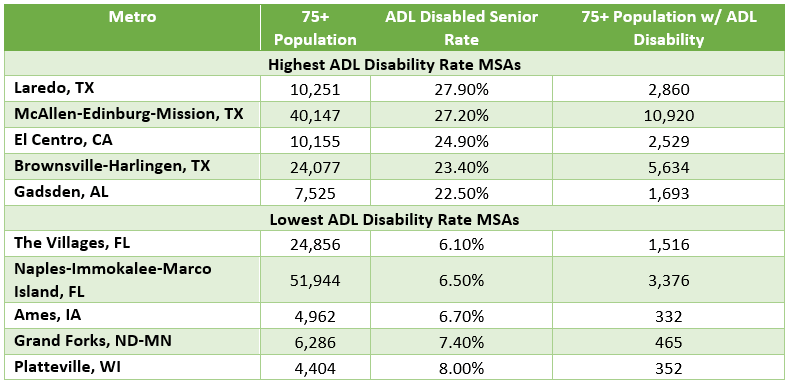
We all know that 100% of people who may need professional services do not seek them out. The seeking services assumption typically hovers around 25%, so we’ll use that for our example. Once we’ve applied the 25% seeking services assumption, we can get a better perspective of the market’s potential need for assisted living services.
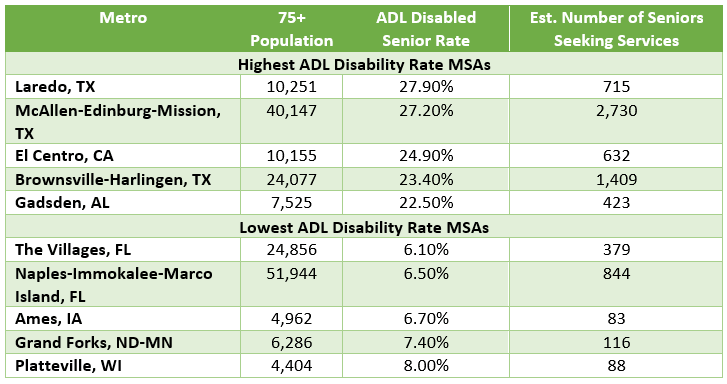
By using an analytics tool, such as VisionLTC, you can quickly assess markets across the US for ADL disability rates or estimated number of seniors seeking services. We believe it’s also important to understand the variance of disability rates within these markets, and to assess these markets for other criteria such as income, demographics, competition, etc.
So, you’ve scanned the country for ADL disability rates and decided that Savannah, GA is an attractive market that you want to focus on, now what?
Assessing the market conditions of Savannah, GA
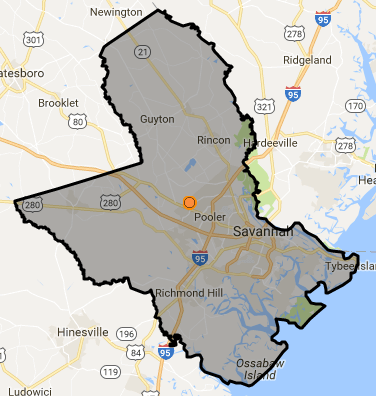 Once you’ve identified a market of interest, the next step is to analyze that market’s various sub-markets to gain an understanding of what geographies are worthwhile and which ones can be ignored.
Once you’ve identified a market of interest, the next step is to analyze that market’s various sub-markets to gain an understanding of what geographies are worthwhile and which ones can be ignored.
This can be done by plotting analysis points throughout the MSA and analyzing the PMA, such as a 3-mile radius, of each point. You can also look at the demographic variance of the census tracts that make up the MSA.
This MSA has an ADL disabled senior rate of 14.5%, which is above the national average. If we take a closer look at specific census tracts in Savannah, GA, we can see that the areas with the highest disability rates (indicated in dark red) are spread out across the MSA.
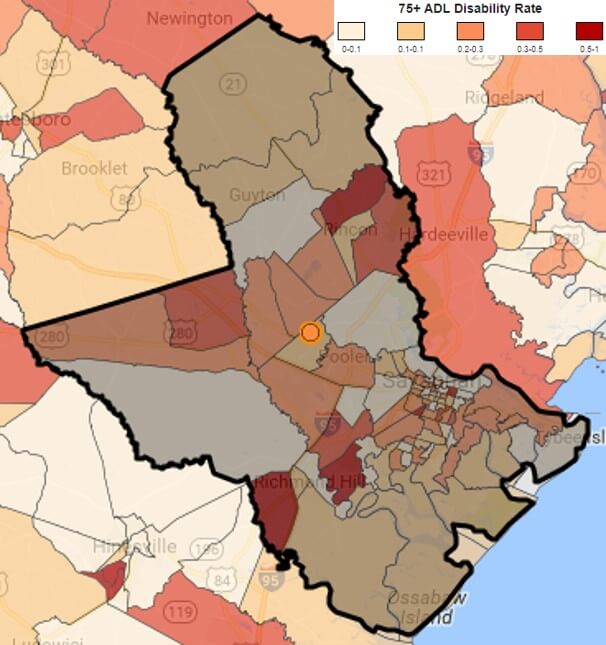
When we analyze 3-mile markets that are distributed across the MSA, we can identify exactly where we want to build our community.
This market has three hot-spots for ADL disability rates, circled on the image below. These markets have disability rates between 10% and 40%, with many of them having disability rates greater than 15%.
You’ll still need to assess the income qualities, population trends, and competition characteristics of these sub-markets, but using the ADL disability rate can be a beneficial tool for screening markets. You can also pair ADL disability rates with competition data to assess the number of ADL disabled seniors per AL bed, which can be useful for identifying markets that are underserved.
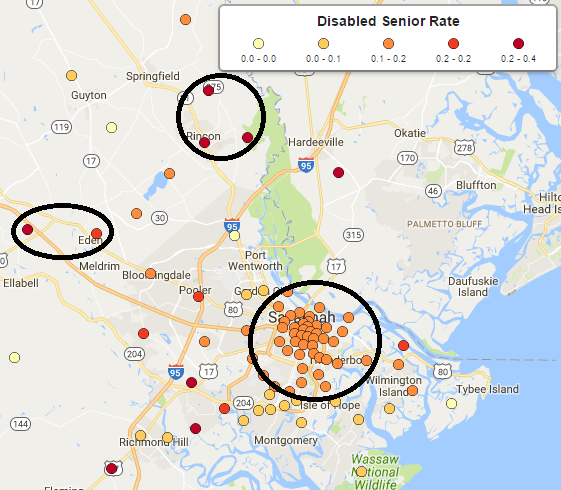
So far, our approach has focused on potential need, but if a market is constantly ignored for new development opportunity, then even a market with a small potential need may provide impressive opportunities. Conversely, a market that has high potential need may be overserved. Using this methodology, Savannah, GA continues to look attractive, because it has market areas that appear underserved.
This approach of using incidence data to identify opportunities for senior-housing, can be used with any metric or combination of metrics. All you need is a set of criteria to look for and a platform for conducting large-scale analysis. If you have methods for screening markets, we’d love to hear them. Share your ideas in the comments or email us!
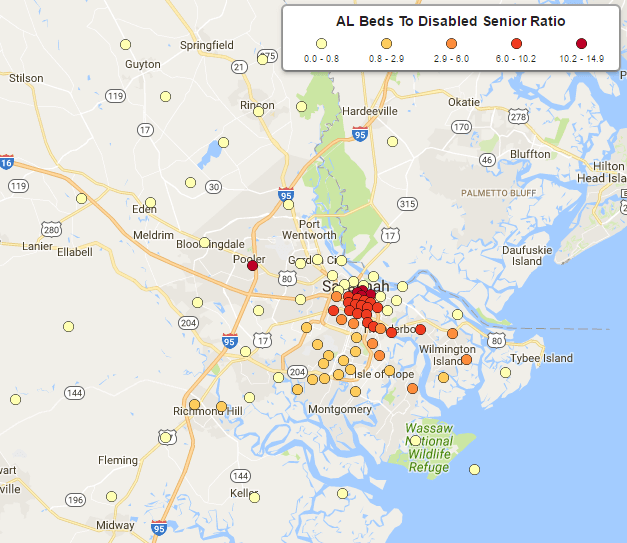
VisionLTC is a market analytics software platform that enables users to complete analyses on markets, sites, geographical areas or portfolios of communities on hundreds of senior-housing focused metrics, in just a matter of minutes. We have over 50 years of operating and investing experience in senior housing facilities and we wanted to make a tool that could empower stakeholders to evaluate markets across the United States, identify ideal areas for development and acquisition opportunities, and benchmark communities against their local market and the broader market.
NIC MAP Vision gives operators, lenders, investors, developers, and owners unparalleled market data for the seniors housing and care sector.
